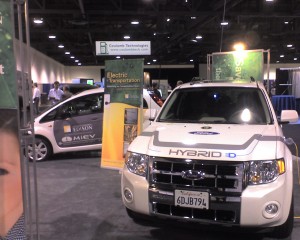
The electric car will facilitate the smart grid and a renewable energy charging infrastructure. The electric car will help make the smart grid relevant to consumers. Right now most cars use inefficient engines fueled with gasoline or diesel. In the coming decades, many cars will use electricity. With a smart grid, renewable energy will do much of the charging.
New electric cars from Nissan, Toyota, GM, Ford and others will use a charging standard J1772. The new charging units at home and work will include a smart meter chip. When a driver plugs-in, charging will follow preferences pre-established by the car owner. Many will prefer to save money and charge at night when rates are cheaper.
States with the earliest adopters of electric cars are also states where utilities face big renewable portfolio standards (RPS). The lowest cost renewable per megawatt is wind, but much of the wind turbine power is delivered at night when winds are most constant. With a smart grid and price incentives, electric cars will be charged off-peak using renewables.
The promise of smart grid electric vehicle charging was discussed at the GreenBeat 2009 conference last week by technology leaders such as Google and Cisco, and utility leaders such as Duke Energy and Southern California Edison. Al Gore presented smart grid and super grid findings from his comprehensive new book about climate solutions – Our Choice.
The current Smart Grid 1.0 is frankly boring. Smart Grid 2.0 promises to make our life better with less use of damaging coal power emissions.
With Smart Grid 1.0, new electric meters are being installed. Utilities save because they no longer need to send people out to read meters. Services can start and stop without rolling trucks to make manual connects and disconnects. Utilities are saving while the consumers pay for the new meters with rate hikes.
As the smart grid conference unfolded, a class action suit unfolded against PG&E, the leader in installing smart meters. The suit filed last week in Kern County Superior Court claims that Pete Flores’s electric bill jumped from $200 per month to over $500 per month after his smart meter was installed. Is it possible that those old mechanical meters sometimes underreported actual electricity use? Are we running more AC with hotter temperatures? We will find out as the suit unfolds. In California higher use can push people into higher pricing tiers.
My wife and I keep our PG&E electric bill under $25 per month by living in a well insulated condo, where I replaced all lights with CFL. Marcia also patiently tolerates living with an environmental journalist that turns off anything not used in the past 30 seconds. Our rate is only 11.5 cents per kilowatt hour. Bigger users in top tiers can pay three times that rate. Pricing works. California has kept electricity use per capita flat, while it has stored in most states.
Electric utility industry has shifted from years of falling costs to rising costs. Utilities need to shift energy use and vehicle charging off-peak to avoid unnecessary investments in expensive peaking power plants. A smart grid is needed to fully utilize renewable energy and moderate fossil fuel emissions.
Public utility commissions are more willing to allow pricing incentives for vehicle charging. Electric cars will help move us to Smart Grid 2.0. Through web browsers, smartphones, and vehicle displays, drivers will select smart charging preferences and get feedback on how to use less electricity and save money. Early electric cars will cost more than their gasoline counterparts, but their electric charging will cost a fraction of the cost of gasoline fill-ups.
Currently, there are only 40,000 electric cars running in the United States. As exciting new offerings are being tested and sold, 1.5 million electric cars are expected in the U.S. by 2015 presented Sharon Allan, the Senior Executive, North American Smart Grid Practice, for Accenture.
Charging these electric cars will help transform the promise of a smart grid into a convenient cost-saving reality.

Many will save money by recharging their batteries from their own solar panels, thus freeing themselves from “electric addiction” of the grid!
Every public charging station should have a solar cell roof overhead that sends energy back to the grid.
@James Miller,
The automakers are finding that goes directly to one of the first questions new EV buyers (& plug-in car buyers) ask–how “green” is my electricity. Pulling electricity off the grid to opportunity-charge plug-ins is not a long-term (or even short-term) solution to our environmental issues. In reality, it may end up creating more by adding at peak demand times.
Michael (editor)